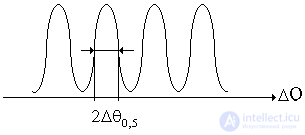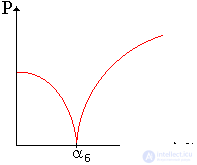Lecture
It is easy to see that the resonance phase condition also holds for a constant wavelength, but a variable angle of incidence.
 ,
,
 .
.
Let us determine the dependence of the resonator field functionally on the angle  (propagation inside the resonator).
(propagation inside the resonator).





 .
.
 ,
,
 ,
,
 . (*)
. (*)
In the formula (*) we consider  - dependence only on the angle of wave propagation. Waves traveling at different angles to the cavity axis form transverse modes, i.e., the stationary field distribution in the transverse direction. Since the field has an uneven distribution, in the far field it is a radiation pattern.
- dependence only on the angle of wave propagation. Waves traveling at different angles to the cavity axis form transverse modes, i.e., the stationary field distribution in the transverse direction. Since the field has an uneven distribution, in the far field it is a radiation pattern.
 ,
,
where R is the far zone, and is the size of the mirror.
 ,
,


 .
.
 ,
,
 ,
,
 .
.

 ,
,
 ,
,
 .
.
From the comparison of the frequency response and the angular characteristics, it follows that the more acute the characteristic, the more selective it is in frequency.
Frequency response and amplitude-angle characteristic
filled active body.

 ,
,
 ,
,

 .
.

The presence of losses in the AE leads to a decrease in the quality factor. The presence of additional density leads to an increase in electrical length.
The non-uniformity of the refractive index in the cross section leads to deformation of the mode, therefore, the angular divergence increases.
 ,
,
M = 1 + n + m,
1,22 - modal multiplier for a round laser.
Heating AE leads to its geometric distortion and additional losses.
Comments
To leave a comment
Quantum electronics
Terms: Quantum electronics